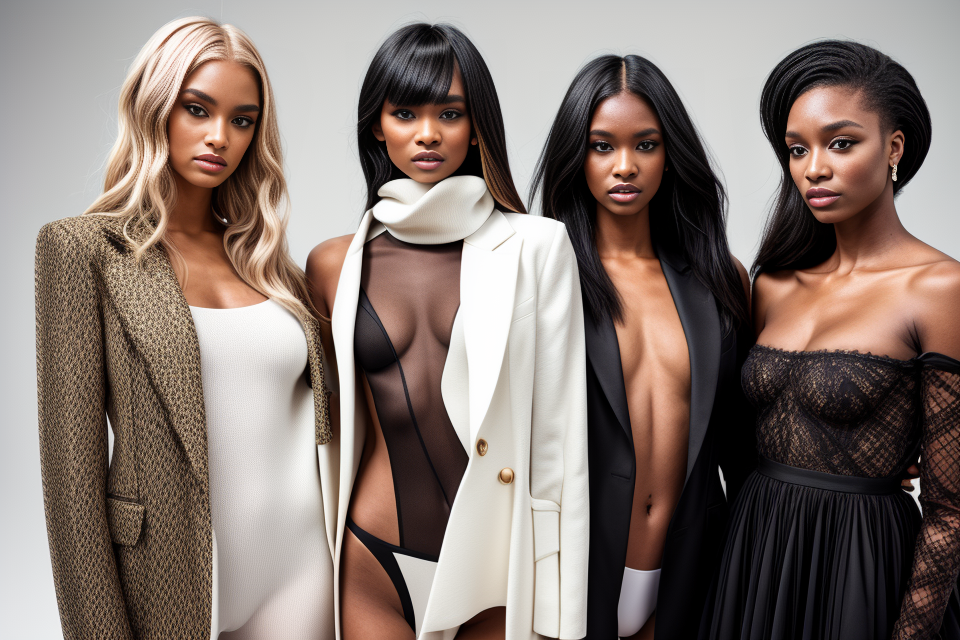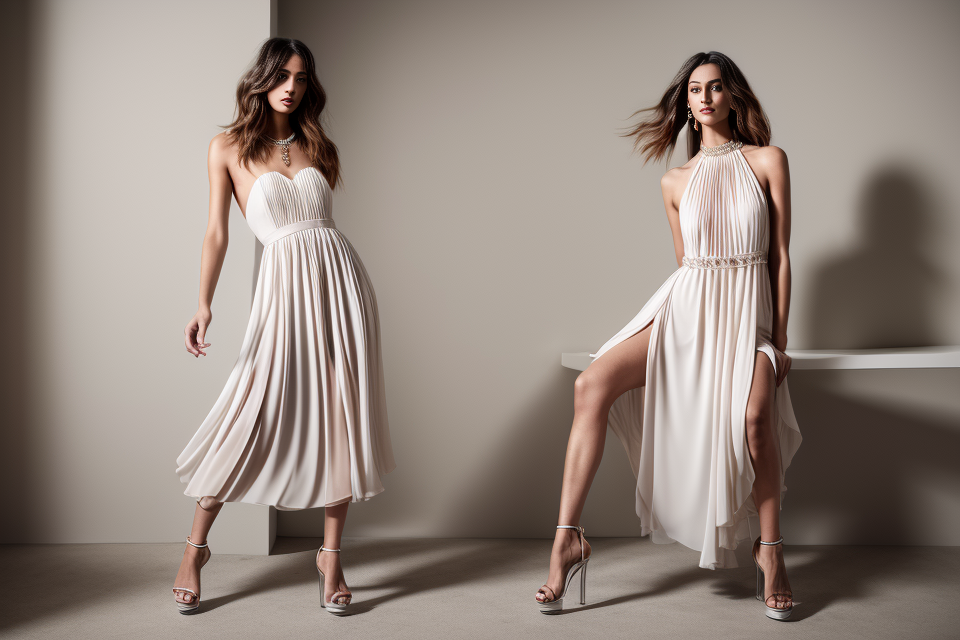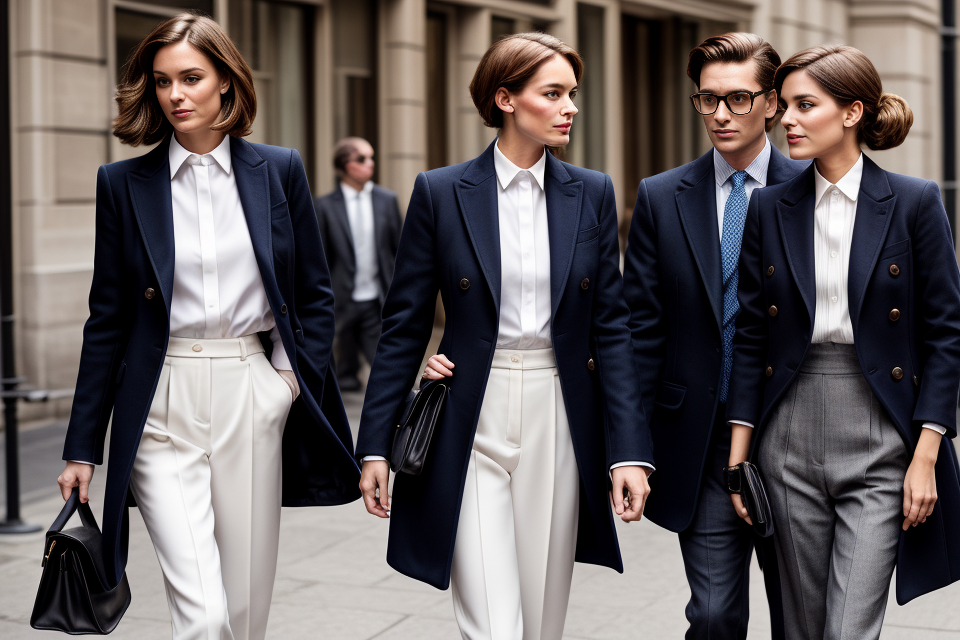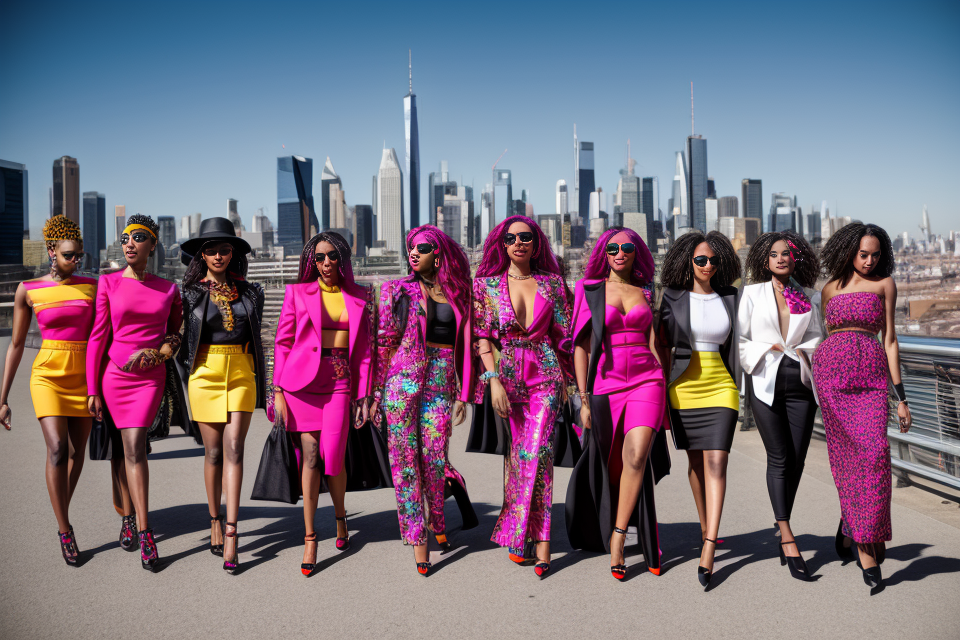
Fashion is more than just a form of self-expression, it is a crucial aspect of our lives that impacts our daily interactions and even shapes our identity. In this article, we will explore the reasons why fashion matters and its significance in our lives. From boosting confidence to reflecting cultural values, fashion plays a vital role in how we perceive ourselves and the world around us. Join us as we delve into the fascinating world of fashion and discover why it truly matters.
The Role of Fashion in Our Lives
How Fashion Affects Our Self-Image
Body Image and Confidence
Fashion plays a significant role in shaping our self-image and influencing our body image. Clothing choices can affect how we perceive ourselves and our level of confidence. For instance, wearing clothes that are comfortable and fit well can boost our confidence and make us feel more positive about ourselves. On the other hand, wearing clothes that are ill-fitting or uncomfortable can negatively impact our body image and lower our self-esteem.
Societal Expectations and Stereotypes
Fashion also affects our self-image by perpetuating societal expectations and stereotypes. In many societies, there are certain fashion styles and trends that are considered acceptable or desirable for different genders, ages, and body types. Adhering to these expectations can make us feel like we fit in and are accepted by others, while deviating from them can lead to feelings of exclusion and rejection.
Furthermore, fashion can reinforce stereotypes and perpetuate harmful beauty standards. For example, the fashion industry often promotes a specific body type as the ideal, which can lead to negative body image and low self-esteem for those who do not fit that mold. Additionally, certain fashion choices can be associated with certain personality traits or lifestyles, which can limit our ability to express ourselves authentically and freely.
Overall, fashion has a significant impact on our self-image and the way we perceive ourselves. While it can be a source of confidence and self-expression, it can also perpetuate societal expectations and harmful beauty standards. Therefore, it is important to be aware of the role that fashion plays in our lives and to make conscious choices that align with our values and beliefs.
Fashion as a Form of Self-Expression
Clothing as a Reflection of Personality
Our clothing choices can reveal a great deal about our personalities. For example, someone who prefers to wear bright, bold colors and bold patterns may be seen as outgoing and confident, while someone who favors more muted, neutral tones may be perceived as more reserved or introspective. The way we dress can also communicate our values and beliefs. For instance, someone who wears sustainable, eco-friendly clothing may be sending a message about their commitment to environmental issues.
Fashion as a Tool for Communication
Fashion can also be used as a tool for communication. By choosing to wear certain clothing items or accessories, we can send specific messages to others about our interests, moods, or social status. For example, wearing a suit and tie to a job interview may signal professionalism and seriousness, while wearing ripped jeans and a T-shirt to a job interview may suggest a more casual, laid-back attitude. In this way, fashion can be a powerful form of nonverbal communication, allowing us to express ourselves without saying a word.
The Psychological Effects of Fashion
The Link Between Fashion and Mental Health
Fashion has a significant impact on our mental health, and this connection is becoming increasingly evident through research in psychology and neuroscience. One of the most significant psychological effects of fashion is the link between clothing and self-esteem. When we wear clothes that make us feel good, we are more likely to feel confident and self-assured, which can have a positive impact on our mental health.
In addition to the link between fashion and self-esteem, there is also evidence to suggest that the way we dress can affect our mood. For example, studies have shown that wearing bright colors can increase feelings of happiness and positivity, while wearing dark colors can make us feel more sad and depressed.
Furthermore, fashion can also be used as a form of self-expression and communication. Through the clothes we wear, we can express our personal style and individuality, which can help us feel more authentic and true to ourselves. Additionally, the clothes we wear can also communicate non-verbally to others, which can impact how we are perceived and treated by others.
Overall, the link between fashion and mental health is a complex and multifaceted one, but it is clear that fashion can have a significant impact on our emotional well-being. By understanding this link, we can better appreciate the importance of fashion in our lives and the role it plays in our overall mental health.
Fashion and Emotional Well-being
Fashion plays a significant role in our emotional well-being, affecting our mood, self-esteem, and even the way we perceive ourselves.
Comfort Clothing and Mental Health
Comfort clothing, such as sportswear and oversized garments, has become increasingly popular in recent years. This trend is not only driven by fashion, but also by the desire for comfort and mental well-being. Wearing comfortable clothing can help individuals feel more relaxed and at ease, which can have a positive impact on their mental health.
Moreover, when individuals are comfortable in their clothing, they are more likely to feel confident and at ease in their own skin. This can have a positive impact on their self-esteem and overall emotional well-being.
The Impact of Fashion on Mood
Fashion can also have a significant impact on our mood. For example, wearing bright and bold colors can make individuals feel more energized and optimistic, while muted and darker colors can make individuals feel more subdued and melancholic.
Additionally, the clothes we wear can influence the way we feel about ourselves and the way we are perceived by others. For example, wearing a well-tailored suit can make individuals feel more confident and professional, while wearing casual clothes can make individuals feel more relaxed and approachable.
Overall, fashion has a significant impact on our emotional well-being, and it is important to consider the psychological effects of fashion when making decisions about what to wear.
The Cultural Significance of Fashion
Fashion as a Mirror of Society
Fashion serves as a reflection of the values, beliefs, and attitudes of a society. It is a visual representation of the culture and times in which it was created. Through the analysis of fashion trends, one can gain insight into the social, economic, and political climate of a particular era.
Trends and Social Change
Fashion trends often parallel social change. For example, the 1960s saw a shift towards more informal wear, reflecting the countercultural movement and the rejection of traditional norms. The 1980s, marked by the rise of consumerism and materialism, was characterized by extravagant and opulent fashion. These changes in fashion trends can be seen as a response to the broader societal shifts happening at the time.
Fashion and Identity
Fashion also plays a significant role in shaping individual and group identity. Clothing can be used to express one’s affiliation with a particular subculture or social group. For instance, the punk movement of the 1970s was defined by its distinctive fashion style, which included ripped jeans, safety pins, and spiky hair. This fashion style served as a visual symbol of the punk movement’s rejection of mainstream society and its values.
Furthermore, fashion can also be used to assert one’s individuality and personal style. Personal fashion choices can communicate one’s taste, preferences, and even political beliefs. For example, the rise of sustainable fashion in recent years has led to an increase in the popularity of eco-friendly and ethically produced clothing. This trend reflects a growing awareness of environmental issues and a desire to make more conscious consumption choices.
In conclusion, fashion serves as a mirror of society, reflecting its values, beliefs, and attitudes. Through the analysis of fashion trends, one can gain insight into the social, economic, and political climate of a particular era. Additionally, fashion plays a significant role in shaping individual and group identity, allowing individuals to express their personal style and values.
The Global Fashion Industry
Economic Impact
The global fashion industry is a significant contributor to the world’s economy. It generates trillions of dollars in revenue each year and employs millions of people across the globe. From designers and manufacturers to retailers and marketers, the fashion industry supports a vast network of businesses and individuals. In addition, the industry is responsible for a significant portion of the world’s textile production, with many countries relying on it as a major source of income.
Sustainability and Ethics
The global fashion industry has come under scrutiny in recent years for its environmental and ethical practices. The rapid pace of fashion production has led to significant environmental impacts, including water pollution, carbon emissions, and waste generation. In addition, the industry has been criticized for its labor practices, with many workers facing poor working conditions and low wages. As a result, there is a growing movement towards sustainable and ethical fashion, with consumers and industry professionals alike calling for more responsible practices. Many designers and brands are now incorporating sustainable materials and production methods into their operations, and there is a growing demand for transparency and accountability in the industry.
The Business of Fashion
The Fashion Industry’s Influence on the Economy
Employment and Entrepreneurship
The fashion industry is a significant contributor to the global economy, providing employment opportunities for millions of people worldwide. It offers a wide range of career paths, from design and production to marketing and retail. The industry’s impact on employment is particularly notable in countries where fashion is a major export, such as Italy, France, and the United Kingdom. In addition, the rise of e-commerce has created new opportunities for entrepreneurs, enabling them to reach a global audience and expand their businesses beyond traditional brick-and-mortar stores.
Fashion and Local Communities
The fashion industry also plays a vital role in supporting local communities. Many fashion brands and retailers source their materials and labor from local suppliers, which helps to preserve traditional crafts and support artisanal production. This approach not only helps to maintain cultural heritage but also contributes to the local economy by creating jobs and generating income. In addition, fashion events and shows often serve as a platform for emerging designers and artists, providing them with a valuable opportunity to showcase their work and gain exposure. By supporting local fashion initiatives, consumers can contribute to the preservation of cultural heritage and the promotion of sustainable development in their communities.
The Future of Fashion
Technological Advancements
As technology continues to evolve, the fashion industry is undergoing a digital transformation. The rise of e-commerce has revolutionized the way fashion brands reach their customers, allowing them to sell their products directly to consumers online. This has opened up new opportunities for small and independent designers, who can now reach a global audience without the need for physical retail spaces.
Moreover, advancements in artificial intelligence and machine learning are enabling fashion brands to use data to drive their business decisions. For example, AI algorithms can analyze customer data to predict future trends and help brands make informed decisions about their product offerings. Additionally, virtual reality and augmented reality technologies are being used to enhance the shopping experience for customers, allowing them to try on clothes and accessories virtually before making a purchase.
Sustainable and Ethical Practices
The fashion industry has come under increased scrutiny in recent years for its impact on the environment and for unethical labor practices. As a result, many fashion brands are making a concerted effort to become more sustainable and ethical in their operations.
One way that brands are achieving this is by using sustainable materials in their products. For example, some designers are using recycled materials to create new garments, while others are using organic cotton and other eco-friendly fabrics. Additionally, many brands are implementing circular business models, which involve reusing and recycling materials to reduce waste and minimize their environmental impact.
Another key area of focus for sustainable fashion is labor practices. Many brands are working to ensure that their supply chains are free from exploitation and that workers are paid fair wages. This includes implementing rigorous auditing processes to monitor working conditions and ensure that labor standards are being met.
Overall, the future of fashion looks to be one that prioritizes sustainability and ethical practices, with brands working to create a more responsible and transparent industry.
Personal Style and Fashion Choices
Developing a Personal Style
Developing a personal style is a crucial aspect of fashion, as it allows individuals to express their unique identity and personality through their clothing choices. Here are some ways in which one can develop their personal style:
Influencers and Style Icons
One way to develop a personal style is by looking to fashion influencers and style icons for inspiration. These individuals have already established a distinct and recognizable aesthetic, which can serve as a starting point for someone looking to develop their own style. For example, a person who admires the bohemian style of actress Sienna Miller might incorporate elements of that style into their own wardrobe, such as flowing dresses and statement jewelry.
Experimenting with Different Looks
Another way to develop a personal style is by experimenting with different looks and styles. This can involve trying out new trends, experimenting with different colors and patterns, and playing with different silhouettes and cuts. By trying out different styles, individuals can discover what flatters their body shape and personal taste, and can develop a style that feels uniquely their own.
Additionally, it’s important to consider one’s lifestyle and personal preferences when developing a personal style. For example, if someone leads an active lifestyle, they may prefer clothing that is comfortable and functional, such as athletic wear or practical footwear. On the other hand, if someone enjoys dressing up for special occasions, they may prioritize fashionable and statement-making pieces in their wardrobe.
Overall, developing a personal style is a process of self-discovery and experimentation, and involves taking into account one’s individual preferences, lifestyle, and body shape. By doing so, individuals can create a unique and authentic style that reflects their personality and identity.
The Impact of Fashion Choices on Others
Workplace Dress Codes
In the workplace, dress codes play a significant role in shaping an individual’s perception and professional image. Compliance with the company’s dress code policy can help create a sense of unity and professionalism among employees. For instance, formal attire can instill a sense of seriousness and professionalism, while casual clothing may promote a more relaxed and informal atmosphere. However, violations of dress code policies can result in negative consequences, such as disciplinary actions or termination of employment.
Social Norms and Fashion
Fashion choices can also impact an individual’s social standing and acceptance within a particular group or community. In some social settings, adherence to specific fashion norms may be expected, and failure to conform may result in social exclusion or criticism. On the other hand, following fashion trends can also be a means of expressing individuality and personal style, which can enhance one’s social status and acceptance within a group. Therefore, the impact of fashion choices on others is multifaceted and can be influenced by various social and cultural factors.
The Importance of Fashion in Our Lives
Emotional and Psychological Benefits
Fashion has the power to make us feel confident, powerful, and attractive. Our clothing choices can also be a form of self-expression, allowing us to showcase our unique personalities and style. By dressing in a way that makes us feel good, we can boost our self-esteem and improve our overall mental well-being.
Cultural and Social Significance
Fashion is not just about personal style; it also plays a significant role in shaping cultural and social norms. Clothing can communicate social status, cultural identity, and political beliefs. It can also be a form of activism, with designers and consumers using fashion to raise awareness about important social and environmental issues.
The Future of Fashion and Its Impact on Society
As the fashion industry continues to evolve, it will be important to consider the impact of our fashion choices on the environment and society as a whole. Sustainable and ethical fashion practices will become increasingly important, as consumers and designers work to reduce waste and promote fair labor practices. Additionally, advances in technology will continue to shape the fashion industry, with new materials and production techniques offering new possibilities for sustainable and innovative fashion.
FAQs
1. Why is fashion important in our lives?
Fashion plays a significant role in our lives as it allows us to express ourselves and our personalities. It is a form of self-expression that can communicate our mood, social status, and even political views. Moreover, fashion is an essential aspect of our daily lives as it helps us to present ourselves in a way that reflects our individuality and unique style.
2. How does fashion impact society?
Fashion has a profound impact on society as it influences the way people think, feel, and behave. It can shape cultural norms, influence social hierarchies, and even reflect economic and political trends. Additionally, fashion is a multi-billion dollar industry that creates employment opportunities and contributes to the economy.
3. Is fashion only about appearances?
While fashion is often associated with appearances, it is much more than that. Fashion is a form of art and design that involves creativity, innovation, and technical skill. It also involves the production, distribution, and marketing of clothing and accessories, which are essential components of the fashion industry.
4. Can fashion be used as a tool for social change?
Absolutely! Fashion has been used as a tool for social change throughout history. It has been used to challenge social norms, promote gender equality, and raise awareness about important issues such as environmental sustainability and human rights. Additionally, many fashion designers and brands are committed to using their platforms to promote positive change.
5. Is fashion only for the wealthy?
No, fashion is not only for the wealthy. While high-end fashion brands and luxury items can be expensive, there are many affordable options available for people of all income levels. Moreover, fashion is not just about buying expensive clothes and accessories, it is also about being creative and expressing oneself through personal style.


